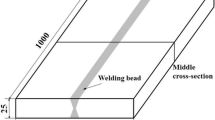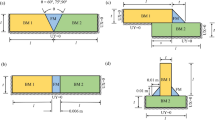Abstract
A three-dimensional finite element model based on thermal–metallurgical–mechanical coupling theory was developed to simulate temperature field, phase fraction and residual stress distribution of a multi-pass P92 steel butt-welded joint. In the FE model, the influences of volume change, yield strength variation and plasticity induced by phase transformation on welding residual stress were carefully taken into account. In addition, an attempt was made to consider the effect of tempering on residual stress. In the current study, the hole-drilling method was employed to measure the residual stress distribution on the surface of P92 steel butt-welded joint, while optical microscope and Vickers hardness tester were used to characterize the microstructure and hardness, respectively. The comparison between the simulation results and the measured data shows that the developed computational approach could accurately predict welding residual stress for multi-pass P92 steel joint. Moreover, the results of Satoh test indicate that the tempering effect has influence on the stress evolution and the final magnitude to a certain extent.






source and (b) waving heat source











Similar content being viewed by others
References
M. Yoshizawa and M. Igarashi, Long-Term Creep Deformation Characteristics of Advanced Ferritic Steels for USC Power Plants, Int. J. Pressure Vessels Pip., 2007, 84(1–2), p 37–43
F.J.S. Abe and T. Materials, Precipitate Design for Creep Strengthening of 9% Cr Tempered Martensitic Steel for Ultra-Supercritical Power Plants, Sci. Technol. Adv. Mater., 2008, 9(1), p 013002
C. Pandey et al., Evolution of Phases in P91 Steel in Various Heat Treatment Conditions and Their Effect on Microstructure Stability and Mechanical Properties, Mater. Sci. Eng: A., 2016, 664, p 58–74
J. Hald, Microstructure and Long-Term Creep Properties of 9–12% Cr Steels, Int. J. Pressure Vessels Pip., 2008, 85(1–2), p 30–37
D. Rojas et al., 9% Cr Heat Resistant Steels: Alloy Design, Microstructure Evolution and Creep Response at 650 C, Mater. Sci. Eng: A, 2011, 528(15), p 5164–5176
R. Viswanathan and W. Bakker, Materials for Ultrasupercritical Coal Power Plants—Boiler Materials: Part 1, J. Mater. Eng. Perf., 2001, 10(1), p 81–95
D. Deng et al., Influence of Solid-State Phase Transformation on Residual Stress in P92steel Welded Joint, Metall. Sin., 2016, 52(4), p 394–402
D. Deng and H. Murakawa, Influence of Transformation Induced Plasticity on Simulated Results of Welding Residual Stress in Low Temperature Transformation Steel, Comput. Mater. Sci., 2013, 78, p 55–62
D. Deng and H. Murakawa, Prediction of Welding Residual Stress in Multi-pass Butt-Welded Modified 9Cr–1Mo Steel Pipe Considering Phase Transformation Effects, Comput. Mater. Sci., 2006, 37(3), p 209–219
G. Buchheim et al., Failure Investigation of a Low Chrome Long-Seam Weld in a High-Temperature Refinery Pi** System, J. Pressure Vessel Technol., 1995, 117(3), p 227–237
A. Výrostková et al., Phase Evolution in P92 and E911 Weld Metals During Ageing, Mater. Sci. Eng. A, 2008, 480(1–2), p 289–298
W. Liang et al., Investigation of Welding Residual Stress Distribution in a Thick-Plate Joint with an Emphasis on the Features Near Weld End-Start, Mater. Des., 2015, 67, p 303–312
D. Abson and J.S. Rothwell, Review of Type IV Cracking of Weldments in 9–12% Cr Creep Strength Enhanced Ferritic Steels, Int. Mater. Rev., 2013, 58(8), p 437–473
J. Francis et al., Review Type IV Cracking in Ferritic Power Plant Steels, Mater. Sci. Technol., 2006, 22(12), p 1387–1395
J. An et al., Analysis of the Creep Behavior of P92 Steel Welded Joint, J. Mater. Eng. Perf., 2011, 20(8), p 1474–1480
A. Yaghi et al., Finite element Simulation of Welding Residual Stresses in Martensitic Steel Pipes, Mater. Res. Innov., 2013, 17(5), p 306–311
A. Yaghi et al., Residual Stress Simulation in Welded Sections of P91 Pipes, J. Mater. Process. Technol., 2005, 167(2–3), p 480–487
A. Yaghi et al., Finite Element Simulation of Residual Stresses Induced by the Dissimilar Welding of a P92 Steel Pipe with Weld Metal IN625, Int. J. Pressure Vessels Pip., 2013, 111, p 173–186
S. Li et al., Numerical Investigation of Formation Mechanism of Welding Residual Stress in P92 Steel Multi-pass Joints, J. Mater. Process. Technol., 2017, 244, p 240–252
C. Pandey, M.M. Mahapatra, and P. Kumar, A Comparative Study of Transverse Shrinkage Stresses and Residual Stresses in P91 Welded Pipe Including Plasticity Error, Arch. Civil Mech. Eng., 2018, 18(3), p 1000–1011
H. Dai et al., Prediction of Residual Stress Distributions for Single Weld Beads Deposited on to SA508 Steel Including Phase Transformation Effects, Mater. Sci. Technol., 2010, 26(8), p 940–949
C.J. Hamelin et al., Validation of a Numerical Model Used to Predict Phase Distribution and Residual Stress in Ferritic Steel Weldments, Acta Mater., 2014, 75, p 1–19
J. Dixneit et al., In-Situ Load Analysis in Multi-run Welding Using LTT Filler Materials, Weld. World, 2016, 60(6), p 1159–1168
F. Kong, S. Santhanakrishnan, and R. Kovacevic, Numerical Modeling and Experimental Study of Thermally Induced Residual Stress in the Direct Diode Laser Heat Treatment of Dual-Phase 980 Steel, Int. J. Adv. Manuf. Technol., 2013, 68(9), p 2419–2430
A. Burgos et al., Alternative PWHT to Improve High-Temperature Mechanical Properties of Advanced 9Cr Steel Welds, J. Mater. Eng. Perf., 2018, 27(12), p 6328–6338
J.A. Francis, W. Mazur, and H.K.D.H. Bhadeshia, Review Type IV Cracking in Ferritic Power Plant Steels, Mater. Sci. Technol., 2006, 22(12), p 1387–1395
S. Issler et al., Weld Repair of Ferritic Welded Materials for High Temperature Application, Int. Mater. Rev., 2004, 49(5), p 299–324
D. Koistinen, A General Equation Prescribing the Extent of the Austenite-Martensite Transformation in Pure Iron-Carbon Alloys and Plain Carbon Steels, Acta Metall., 1959, 7, p 59–60
J. Leblond and J. Devaux, A New Kinetic Model for Anisothermal Metallurgical Transformations in Steels Including Effect of Austenite Grain Size, Acta Metall., 1984, 32(1), p 137–146
E837-08e2, A, Standard Test Method for Determining Residual Stresses by the Hole-Drilling Strain-Gage Method, ASTM International, West Conshohocken, 2009
A. Giri et al., On the Estimation of Error in Measuring the Residual Stress by Strain Gauge Rosette, Measurement, 2015, 65, p 41–49
J. Goldak, A. Chakravarti, and M. Bibby, A New Finite Element Model for Welding Heat Sources, Metall. Trans. B, 1984, 15(2), p 299–305
D. Deng and H. Murakawa, Finite Element Analysis of Temperature Field, Microstructure and Residual Stress in Multi-pass Butt-Welded 2.25 Cr–1Mo Steel Pipes, Comput. Mater. Sci., 2008, 43(4), p 681–695
N. Saini, C. Pandey, and M. Mahapatra, Microstructure Evolution and Mechanical Properties of Dissimilar Welded Joint of P911 and P92 Steel for Subsequent PWHT and N&T Treatment, Transactions of the Indian Institute of Metals, New York, 2017
Version, E.G.J.D., SYSWELD 2010 Reference Manual (2010).
J.B. Leblond, J. Devaux, and J.C. Devaux, Mathematical Modelling of Transformation Plasticity in Steels I: Case of Ideal-Plastic Phases, Int. J. Plast., 1989, 5(6), p 551–572
K.J.T.O.T.J.W.S. Satoh, Transient Thermal Stresses of Weld Heat-Affected Zone by Both-Ends-Fixed Bar Analogy, Trans. Jpn. Weld. Soc., 1972, 3(1), p 125–134
Acknowledgments
This work was supported by the National Natural Science Foundation of China [Grant Nos. 51875063 and 51275544].
Author information
Authors and Affiliations
Corresponding author
Additional information
Publisher's Note
Springer Nature remains neutral with regard to jurisdictional claims in published maps and institutional affiliations.
Rights and permissions
About this article
Cite this article
Ren, S., Li, S., Wang, Y. et al. Predicting Welding Residual Stress of a Multi-pass P92 Steel Butt-Welded Joint with Consideration of Phase Transformation and Tempering Effect. J. of Materi Eng and Perform 28, 7452–7463 (2019). https://doi.org/10.1007/s11665-019-04470-9
Received:
Revised:
Published:
Issue Date:
DOI: https://doi.org/10.1007/s11665-019-04470-9




